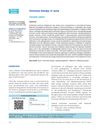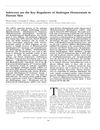Inhibition of Rat 5α-Reductase Activity and Testosterone-Induced Sebum Synthesis in Hamster Sebocytes by an Extract of Quercus Acutissima Cortex
January 2015
in “
Evidence-based Complementary and Alternative Medicine
”

TLDR An extract from Quercus acutissima bark was found to reduce sebum production and block an enzyme linked to acne.
In a 2015 study, an extract from the cortex of Quercus acutissima (BK) was found to inhibit 5α-reductase activity and testosterone-induced sebum synthesis in hamster sebocytes. BK reduced the conversion of testosterone to dihydrotestosterone (DHT) in rat liver microsomes and suppressed lipogenesis in hamster sebocytes, with pentagalloyl glucose identified as the most active compound in BK. The study demonstrated that BK and pentagalloyl glucose could be potential treatments for acne vulgaris by inhibiting 5α-reductase activity and reducing sebum production. The IC50 values for the inhibitory activity of different constituents ranged from 2.5 to 12.6 μmol/L, and BK also inhibited superoxide production in a hypoxanthine-xanthine oxidase system. The number of experiments conducted for each test sample was 3 (N=3).


